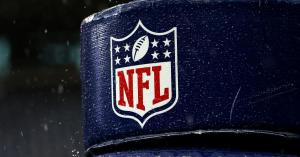The first Game of Thrones spinoff series appears to have its official title in place: Bloodmoon. Across the Internet, die-hard fans are now theorizing on what that name could imply about the series.
HBO has ordered a pilot from Bloodmoon, one of the three Game of Thrones spinoff series still in development. The show is reportedly a far-flung prequel, taking place at least 5,000 years before the main series.
Videos by PopCulture.com
Previously, author George R.R. Martin said that his preferred title for the series would be The Long Night, as it would be set during the end of the Age of Heroes, and tell of the White Walkers’ first attack on Westeros. However, he later clarified that that was his own pet name and HBO had not taken him up on it.
Once production got underway, the series was going by the code name Bloodmoon. At first, fans assumed this was just a temporary shorthand, but in recent weeks it has started to seem like a more serious contender for the title. The fan site Watchers on The Wall even obtained a production sheet showing a logo for Bloodmoon, implying that it could be here to stay.
While it may sound out of place to casual viewers, the title Bloodmoon is actually congruent with a lot of themes and imagery from Martin’s A Song of Ice and Fire. If it is indeed the permanent title, it could tell us a lot about where the show is heading.
Here are some of the major implications of the title Bloodmoon for a Game of Thrones prequel series.
The Logo
“Game of Thrones”: Logo for “Bloodmoon” Prequel Series Reportedly Revealed pic.twitter.com/kZ0N1sKMs9
— ComicsTalks (@comicstalks) June 29, 2019
To begin, there is the newly glimpsed Bloodmoon logo. Stamped at the top of a production sheet, it features the words staggered on top of each other, separated by a long spear. The second O in “Blood” lines up with the first O in “Moon,” and they contain a kind of mirrored image of gradient horizontal lines, the only difference being that the lower O has no outline.
To many, this is an impressionistic rendering of balance and fractal symmetry — as above, so below. It speaks to Martin’s dualistic themes in A Song of Ice and Fire, which literally concerns the war between the existential forces of life and death.
The two round shapes also imply the importance of a literal moon, and perhaps celestial bodies in general. This is an aspect of Martin’s work that the original show never explored too deeply, yet it could open up whole new realms of Westerosi magic if showrunners choose to explore it.
‘The Moon is an Egg, it is Known’

Game of Thrones and A Song of Ice and Fire is filled with its own rich mythology. Many creation stories and ancient beliefs in Martin’s world deal with the moon, in unique and interesting ways. One of the first lunar myths viewers of the show are introduced to is the origin of dragons, as explained by one of Daenerys’ handmaidens in Season 1.
“A trader from Qarth told me that dragons come from the moon,” she said. “He told me the moon was an egg, Khaleesi. That once, there were two moons in the sky, but one wandered too close to the sun and it cracked from the heat. Out of it poured a thousand-thousand dragons, and they drank the sun’s fire.”
The Khaleesi’s other handmaidens fire back with an equally curious moon myth.
“Moon is no egg. Moon is goddess, wife of sun. It is known,” they say.
In either case, these myths imply a significance of celestial events that can be felt by humans on earth. The Qarthine story even hints that the moon, and perhaps some ancient cataclysm in this fictional world, are behind the magic of dragons, fire and blood.
The ‘Two Moons’ Theory

Over the years, fans have often theorized about the real celestial origins of the myths in Martin’s series. Many believe, based on mounting textual evidence, that there really were two moons in the ancient past of Westeros. They believe that every culture remembers the destruction of the second moon in its own way, and that all of the varying myths are a retelling of this story.
This is called a monomyth — a single story rehashed through the lens of the culture in question. However, in this fantasy world, the myths have real world effects, fueling different types of magic such as the dragon taming and fire magic of Daenerys’ ancestors, or the Wierwood magic of House Stark.
Either way, the title Bloodmoon would seem to suggest that we will get some practical explanations for the rise of magic in Westeros.
Azor Ahai & The Bloodstone Emperor

If the monomyth theories are true, we could expect to see some of their foundations in the prequel series. It may be that we will see the true events that inspired myths like the legendary hero Azor Ahai and the Bloodstone Emperor of the east. It could even prove once and for all that these figures are the same.
The show would then be faced with the interesting task of making these fantasy myths literal and cohesive. As fans know, Azor Ahai, “The Prince That was Promised,” was an ancient hero of the east who fought back the forces of darkness in the world. He did so with the magic sword Lightbringer, which he created by tempering it in the blood of his beloved wife, Nissa Nissa.
The books themselves tell us that Azor Ahai has many other names in different cultures, including Hyrkoon the Hero and Eldric Shadowchaser in the west. Fans have theorized that this story could just be the personification of a celestial event — the sun (Azor Ahai) appeared to spit out a comet (Lightbringer) which then impacted the moon (Nissa Nissa), killing her but bringing magic to humankind.
A similar myth from the far east tells of The Bloodstone Emperor, a god-king who ruled the Great Empire of The Dawn for hundreds of years. He is said to have worshipped a black stone that fell from the sky — not unlike a meteor, and used its power to bring about the Long Night.
Many fans expect the prequel to reconcile some of these archetypes into real characters, and give us a hint as to how they became myths. This would be an interesting method of storytelling, like hearing the first words uttered in a game of telephone.
The Last Hero, The Prince That was Promised & Hugor of the Hill

There are many other archetypes in Westerosi mythology, and fan theorists debate which ones line up with which, and which ones are heroes or villains. That can be tricky in Martin’s work, where the moral gray area rules supreme, but there are a few historical figures fans hope to see on the screen.
The top contender among these is The Last Hero, a figure revered among the First Men, the Free Folk and the Northmen. The Last Hero is an ancient warrior who sought the help of the Children of the Forest against the White Walkers, when the Long Night threatened to wipe humanity out. In the main story, Sam finds an ancient scroll noting that The Last Hero fought with a dragonsteel sword, which he and Jon assume refers to Valyrian steel.
This, of course, could line up with the myth of Azor Ahai recounted above. It also matches with the Andal legend of Hugor of the Hill, also known as Hukko or Hyrkoon. This figure is sacred to the Faith of the Seven — an ancient king that was crowned by The Father himself when he pulled stars down from the sky to crown him. In the prequel, some expect Hugor to appear, though perhaps in a more sinister light than the Septons speak of him in.
The Age of Heroes and the Rise of Valyria

One thing we know for sure is that the series is set at the end of a period called the Age of Heroes and the beginning of the Long Night. Just last year, Martin gave us some clarity on the timeline of these events, which have always been mired in mystery.
In his encyclopedia-style book, The World of Ice & Fire, he notes that the maesters of Westeros guess that the Age of Heroes took place between 10,000 and 8,000 years ago. However, in an interview with Entertainment Weekly in November, he stated that it could have been as recently as 5,000 years ago.
“I think it’s closer to 5,000 years,” he said.
This is huge, as Martin’s maesters know for sure that the Valyrian Freehold began to rise up about 5,000 years before the main series. Valyria is the highly advanced, highly magical ancient civilization that wielded fire magic, forged unbeatable swords and rode dragons into war. In the main series, Daenerys is their last surviving descendant.
While Martin has promised that there are no Targaryens in the prequel, he did not say that there were no Valyrians — or, for that matter, no dragons. If Valyria was building its strength across the sea just as the First Men of Westeros were fighting the White Walkers, it could explain how The Last Hero got a “dragonsteel sword,” and give the show a chance to put dragonriders back on the small screen.
Moreover, the title Bloodmoon carries some dark connotations when related to Valyria. Fans know that Daenerys had to pay a terrible price in blood to gain the power of three dragons, and the books make it clear that she was only guessing at a sacrificial art which her ancestors had mastered. The books are full of references to Valyrian blood magic, so Bloodmoon could document the early days of these practices.
The Spear

Turning back to the Bloodmoon logo, it is worth noting the spear coming between the two words. The simple weapon denotes the prehistoric setting of the series — the First Men of Westeros did not forge steel, and so swords would not have been common.
The spear could also be attributed to the Night King, who we have seen carry a deadly ice javelin, which he can launch hard enough to take down a fully grown dragon. On the other hand, it may relate to Symian Star Eyes, a mythical hero of Westeros who had his eyes gouged out, but replaced them with brilliant blue sapphires. Even without his sight, he was able to spin his double-sided spear, killing any foe who crossed his path.
Bran once wanted to emulate Symian Star Eyes, and Arya eventually did with the dragonglass weapon she used in the Battle of Winterfell. However, many fans still think there is more to that legend, and they expect to see Symian in the prequel. Perhaps not on the side of the living, either, but as a White Walker, considering his icy blue eyes.
Children of the Forest

Lastly, we have to assume that the prequel series will deal with the Children of the Forest quite a bit. The ancient, magical race that inhabited Westeros before humans possessed the wierwood magic and greenseer abilities that we later see Bran inherit. According to legend, they were so powerful that the broke the Arm of Dorne — the land bridge that connected Westeros to Essos, stopping humans from crossing over on foot.
This is a massive act of magic, and as we have seen, all magic comes at a heavy price in Martin’s fictional world. It could be that the title Bloodmoon relates to this desperate act. The Children of the Forest separated the continents because of their war with humans, and in the TV show, they created the White Walkers for the same reason.
It could be that this intervention relates to the celestial event many fans expect to see in the prequel, and the “blood moon” hanging over the entire series. Here, we may even see the magical origin of Westeros’ strange, non-cyclical seasons.
There is still a lot of work to be done in predicting what Bloodmoon holds for fans. In a recent blog post, Martin encouraged fans to look to his latest book, Fire and Blood, for hints, so fans are dissecting that text in preparation for the show.
Bloodmoon is currently filming a pilot in northern Ireland and Italy. If it is picked up to series, it could air as soon as the spring of 2021 on HBO.
Most Viewed
-

NEW YORK CITY – DECEMBER 19: "Toil and Trouble" – Elsbeth is thrown into the world of television after the showrunner of a long-running police procedural is brutally murdered in his office, and although it appears to be the act of a disgruntled fan, she begins to suspect the show's longtime star Regina Coburn (Laurie Metcalf) who yearns for artistic fulfillment. Meanwhile, Judge Crawford (Michael Emerson) continues to be a thorn in Elsbeth's side, on the CBS original series ELSBETH, Thursday, Dec. 19 (10:00-11:00 PM, ET/PT) on the CBS Television Network, and streaming on Paramount+ (live and on demand for Paramount+ with SHOWTIME subscribers, or on demand for Paramount+ Essential subscribers the day after the episode airs). Pictured (L-R): Carrie Preston as Elsbeth Tascioni and Carra Patterson as Kaya Blanke. (Photo by Michael Parmelee/CBS via Getty Images)







